Original title: Protocol design: Why and how
Guide:
Original compilation: Sissi
Guide:
With its in-depth articles, a16z has established an important position in the field of encryption to guide the development of the industry, providing us with the guidance we need for cognitive improvement and transformation. Recently, a16z has been focusing on issues beyond the token economy. first about"token design"protocol design"protocol design"course. As the lecturer of the course, Eddy Lazzarin, CTO of a16z crypto, repeatedly emphasized that the key to surpassing the token economy lies in the protocol design, and the token design is only an auxiliary means. In this course focusing on protocol design, he shared for more than an hour, bringing valuable insights and enlightenment to entrepreneurs, helping them deeply understand the key role of protocol design in project success. This article is a simplified version of the translation. For more exciting content, see the translationfirst level title。
secondary title
Internet Protocol: The Nexus of Interaction
The internet is a network of protocols, containing various different types of protocols. Some protocols are straightforward, such as HTTP's state diagram, while others are quite complex, such as the Maker protocol's interaction diagram. The figure below shows various protocols, including Internet protocols, physical protocols, and political protocols. On the left of the image below, we see an interactive map of a street intersection, which feels familiar and interesting to us.
secondary title
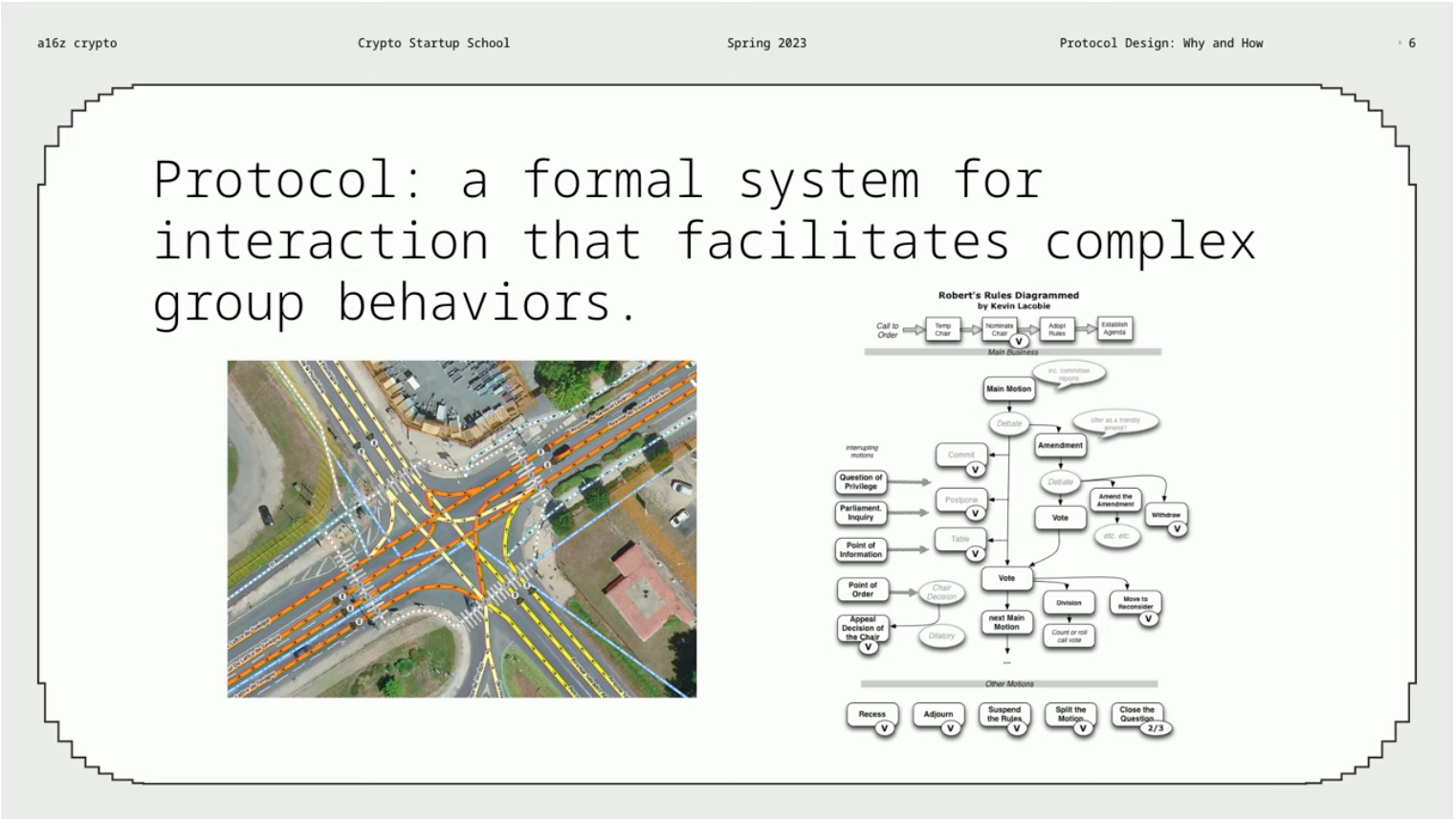
Protocol Evolution: Web1 - Web2 - Web3
text
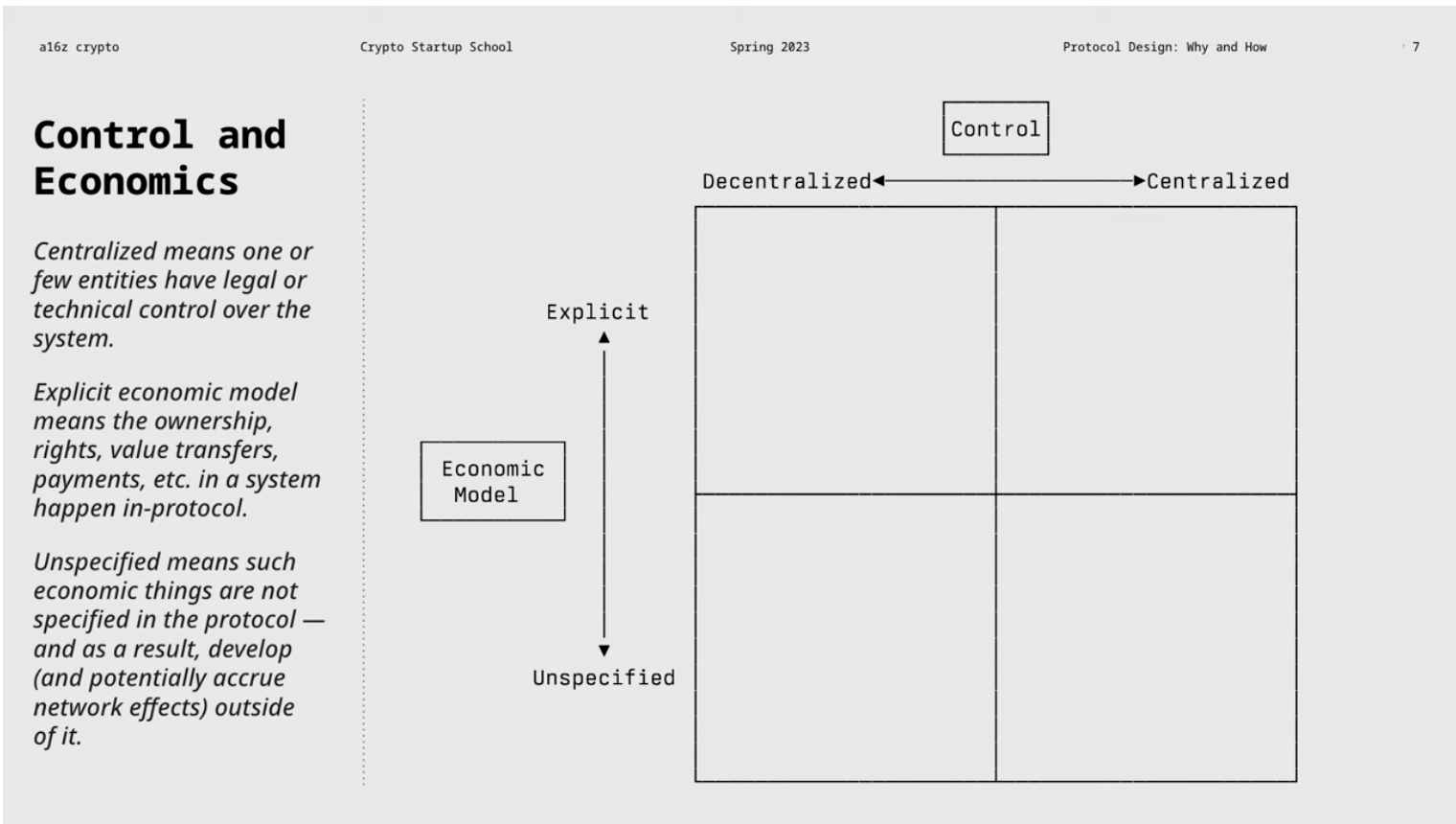
Web1: Decentralized & No Clear Economic Model
a16z Encryption Entrepreneurship Course: After "Token Design", "Protocol Design" is launched

Usenet is a taxonomy-organized platform that allows users to post relevant content on sub-servers of specific categories. It was an important part of early Internet culture and existed outside of HTTP. Using Usenet requires a specific client and an Internet Service Provider (ISP) that supports Usenet. Usenet is distributed across a large number of ever-changing news servers that can be run by anyone, and posts are automatically forwarded to other servers, forming a decentralized system. While users rarely pay for Usenet access directly, in the late 2000s some began paying for commercial Usenet servers. Overall, Usenet lacks a clear protocol economic model, and users must use it through their own transactions.
These Web1 protocols are architecturally similar and derived from the same values. Even with little knowledge of the protocols, we can still understand how they work, which showsThe importance of web1 protocol legibility and clear templates.However, these protocols gradually face failure or change over time. The reason for the failure can be attributed to two aspects:finally,finally,A protocol's ability to take a decentralized approach and develop a sustainable economic model to integrate specific features will determine its success.text

Web2: Centralization & Explicit Economic Model
a16z Encryption Entrepreneurship Course: After "Token Design", "Protocol Design" is launched
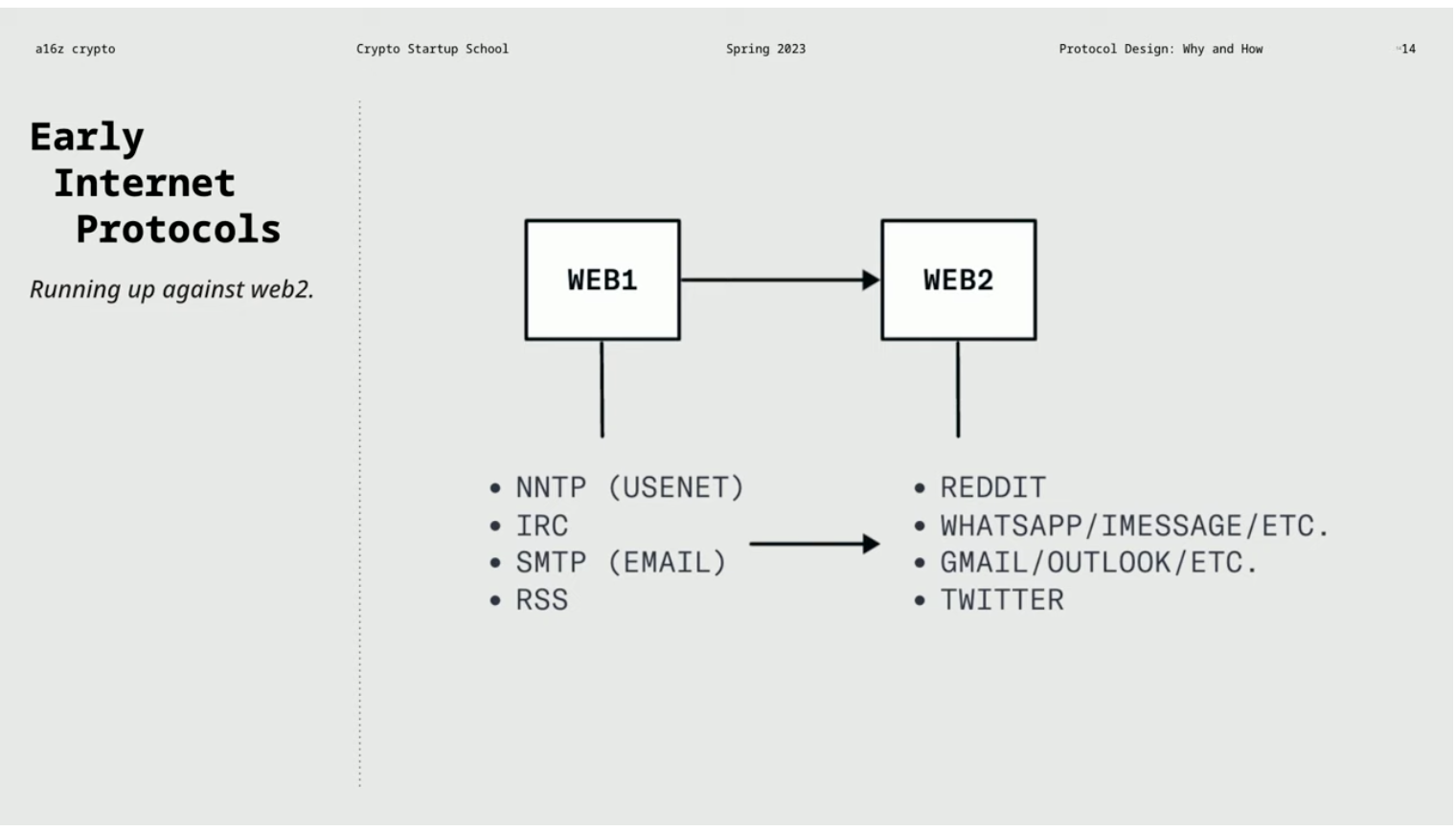
The Web2 protocol is fully under the owner's control, limited only by business policy and law.In order to drive the development of the Web1 protocol, a more explicit economic model is needed. However,Achieving a clear economic model while maintaining decentralization is impossible without leveraging decentralized consensus, verifiable computing, and cryptographic tools.a16z Encryption Entrepreneurship Course: After "Token Design", "Protocol Design" is launched
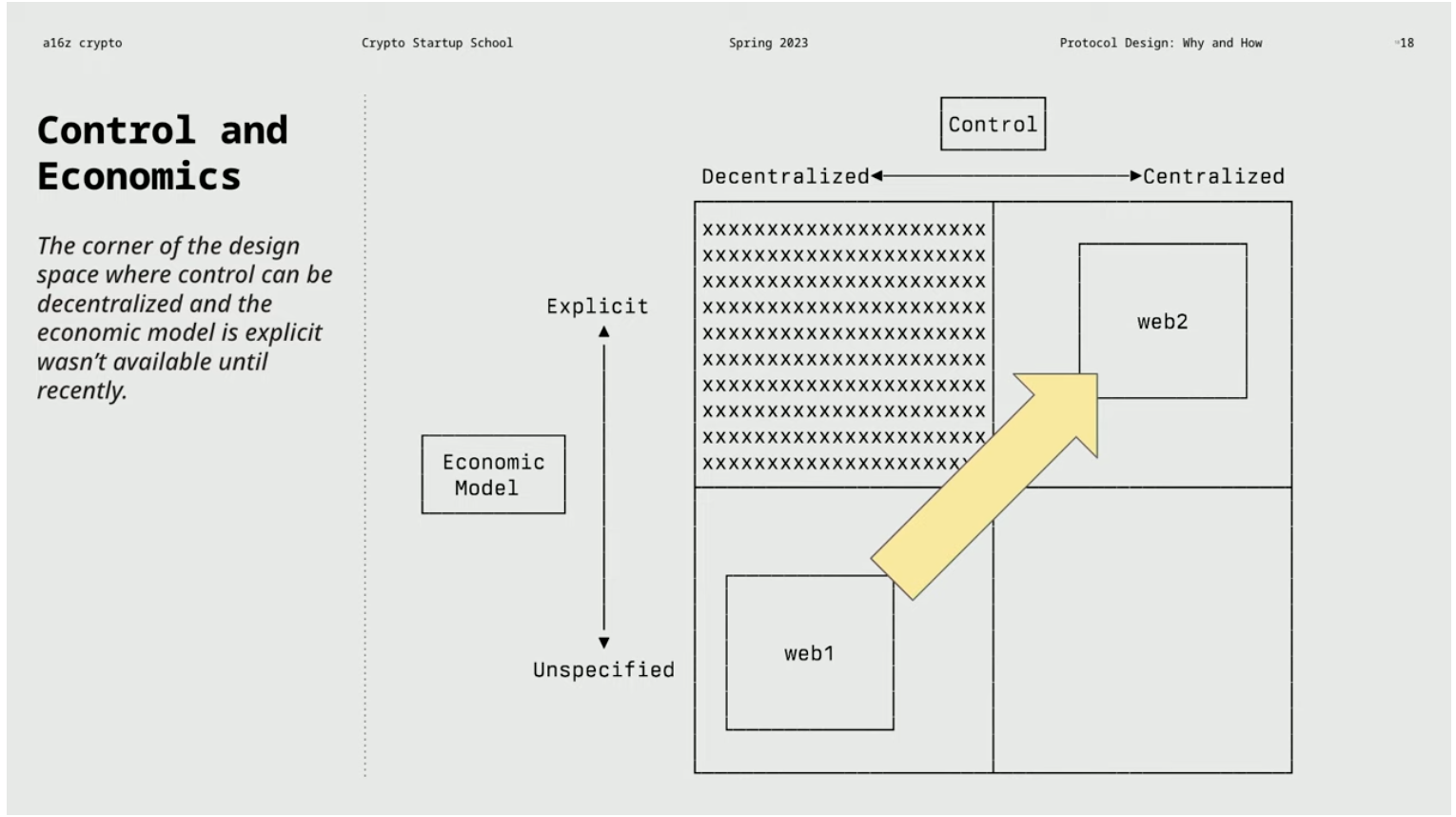
In the absence of a viable economic model, email can only be sustainable as a side project of the big tech companies. Methods to reduce spam rely on economies of scale and data binding, and it is easier for companies hosting millions of email accounts to detect anomalies. In addition, switching costs are also an important factor. Now, we need to realizeTwo key centralizing forces,They affect different components of the protocol,a16z Encryption Entrepreneurship Course: After "Token Design", "Protocol Design" is launched
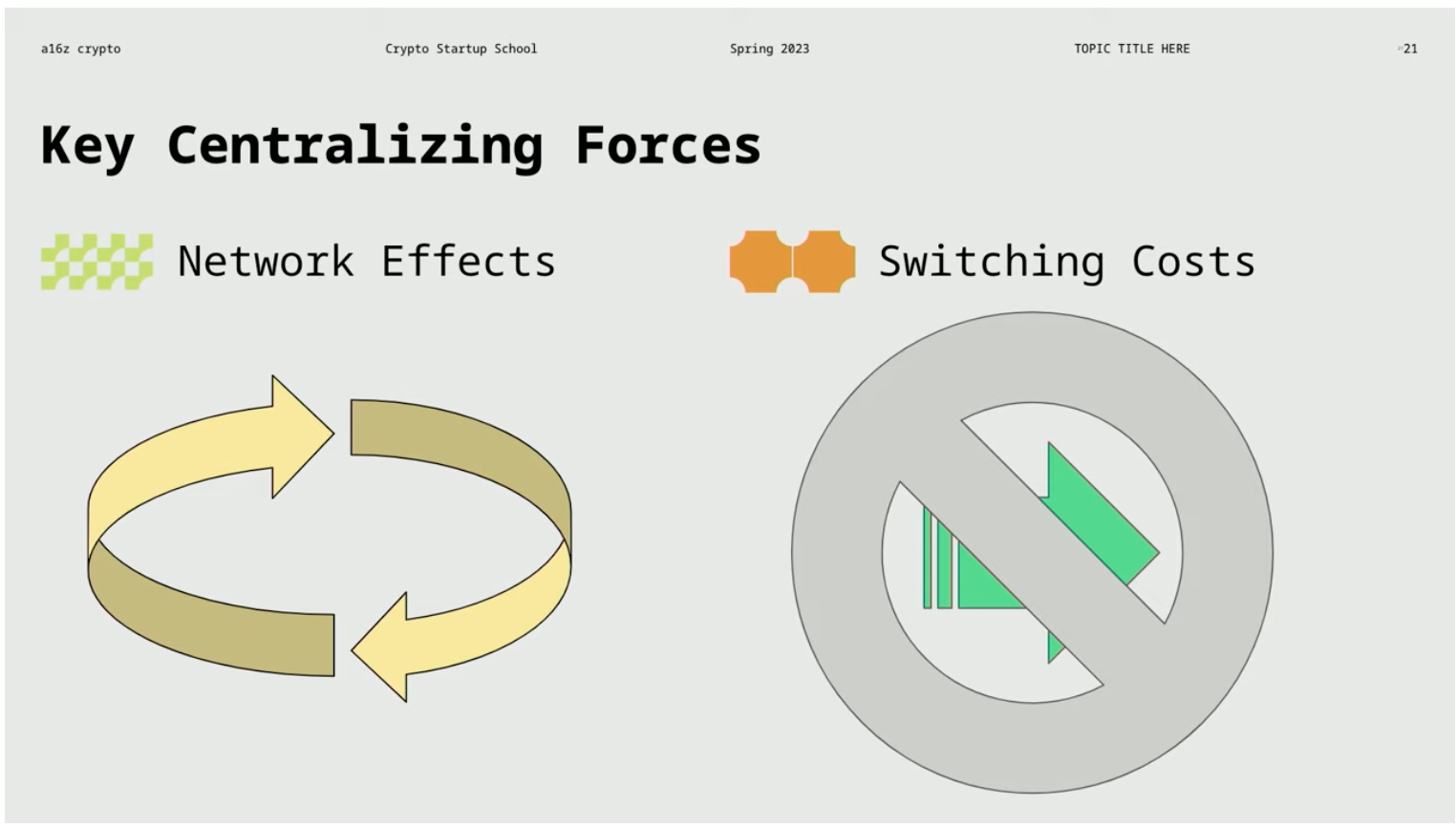
Network effects are the phenomenon of power accumulating as systems scale and become widely used. Switching costs refer to the economic, cognitive, or temporal costs required for users to leave the current system and switch to another system.In the e-mail example, switching costs are critical for users using Gmail. If you use Gmail but don't have your own domain, switching costs will be high. However, if you own your own domain name, you are free to switch mail service providers and continue to use any service provider to receive mail. A company can increase switching costs through protocol design, forcing or encouraging users to use specific components, thereby reducing the likelihood of users switching to other suppliers.
Take Reddit, a system that allows moderators to unilaterally control subforums, blurring the line between decentralization and centralization. While allowing anyone to be a moderator might be seen as a form of decentralization, they are still fully centralized systems if ultimate power remains in the hands of administrators (such as Reddit teams). A high-quality user experience has nothing to do with centralized power, but providing a high-quality user experience often requires financial support.In the era of Web1, due to lack of funds, decentralized protocols often cannot provide a good user experience.Funding plays an important role in delivering a high-quality user experience.
Web3: Decentralized & Clear Economic Model
Like on Twitter, Facebook, Instagram or TikTokOn the Web2 platform, user choices are limited, making them subject to the interface decisions of the platform.However, how will the decentralized components introduced by Web3 change the protocol? Utilizing encryption and blockchain technology can reduce the reliance on trust, while clarifying the economics and supporting decentralization.a16z Encryption Entrepreneurship Course: After "Token Design", "Protocol Design" is launched

As a developer, choosing to build on a decentralized system with a clear economic model is the best choice. This ensures the continued existence of the system and understanding of the economic relationships associated with it without having to allow economic relationships to develop outside of the agreement.In terms of stability and value capture, things need to be thought of differently. Choosing to build on a decentralized system is important because it avoids potential risks and builds a project that is durable and has the potential to be the largest system possible.
Internet construction is no longer regarded as crazy behavior, because the Internet itself is a completely decentralized system. Likewise, the use of open source programming languages and reliance on web browsers has become a solid foundation for building ambitious projects. Building on a centralized system can be limited and prevent the scale and scope of the project. Web3 attracts great developers who can build bigger, more ambitious projects. Other systems or platforms may emerge and compete with the existing Web2 platform, comply with regulations and have a competitive advantage, and compete fiercely with the Web2 platform.
The biggest problem with the Web2 network is its fragility and over-optimized business model. These networks pursue the optimization of specific metrics while ignoring things that are irrelevant to their goals, resulting in a lack of innovation and development of new products.While they have strong network effects, not enough to form a monopoly, they are vulnerable to countermeasures against their weaknesses.
In contrast,Web3 provides a more resilient and innovative space through decentralization and a clear economic model.therefore,
therefore,Web3 has better ecosystem sustainability and innovation potential, rather than relying solely on the accumulation of economic resourcesfirst level title
secondary title
Case Background and Design Goals
a16z Encryption Entrepreneurship Course: After "Token Design", "Protocol Design" is launched

We face an interesting problem:How to expand this system to make it bigger and more professional, while maintaining openness and interoperability, without risking centralization to destroy the original spirit of the project.One proposal is to convert Kudos scores into ERC 20 tokens and record them on the blockchain. However, simply adding blockchain may cause a series of problems, such as false result attacks and so on.
Let's rethink the protocol design process.You should always start with a clear goal, then consider the constraints, and finally define the mechanism.secondary title

Web3 Protocol Example: Unstable Confusion
Let's move on to a discussion called"Unstable Confusion"Convert to Web3 protocol"Stable Horde"Convert to Web3 protocol"Unstable Confusion"proposed in the context of.
As mentioned earlier, there areissues with sending spurious results, so a mechanism is needed to ensure users get what they want,This is called"Verify reasoning". In simple terms, we need to verify the reasoning to ensure that its results are as expected. Another question involves"Stable Horde"workers in. Workers request the next task from the database in the order they were requested, and assign the task to the worker who made the request earliest. But in systems involving money,workersQuests may be claimed in large numbers in order to get paid more, but have no real intention of completing them. themIt may compete for low latency, snatch tasks, and cause system congestion.
Pay proportional to contribution"Pay proportional to contribution"followed byfollowed by"flexible participation", that is, workers can freely join or exit the system at a lower cost, attracting more participants. Finally"low latency", that is, the responsiveness and quickness of the application is critical to the user experience.Going back to our goal, is to build a decentralized, interoperable marketplace for image generation. While we still have some key constraints, these could be added, modified or more specific details later. Now, we can evaluate the feasibility of different mechanisms.
a16z Encryption Entrepreneurship Course: After "Token Design", "Protocol Design" is launched
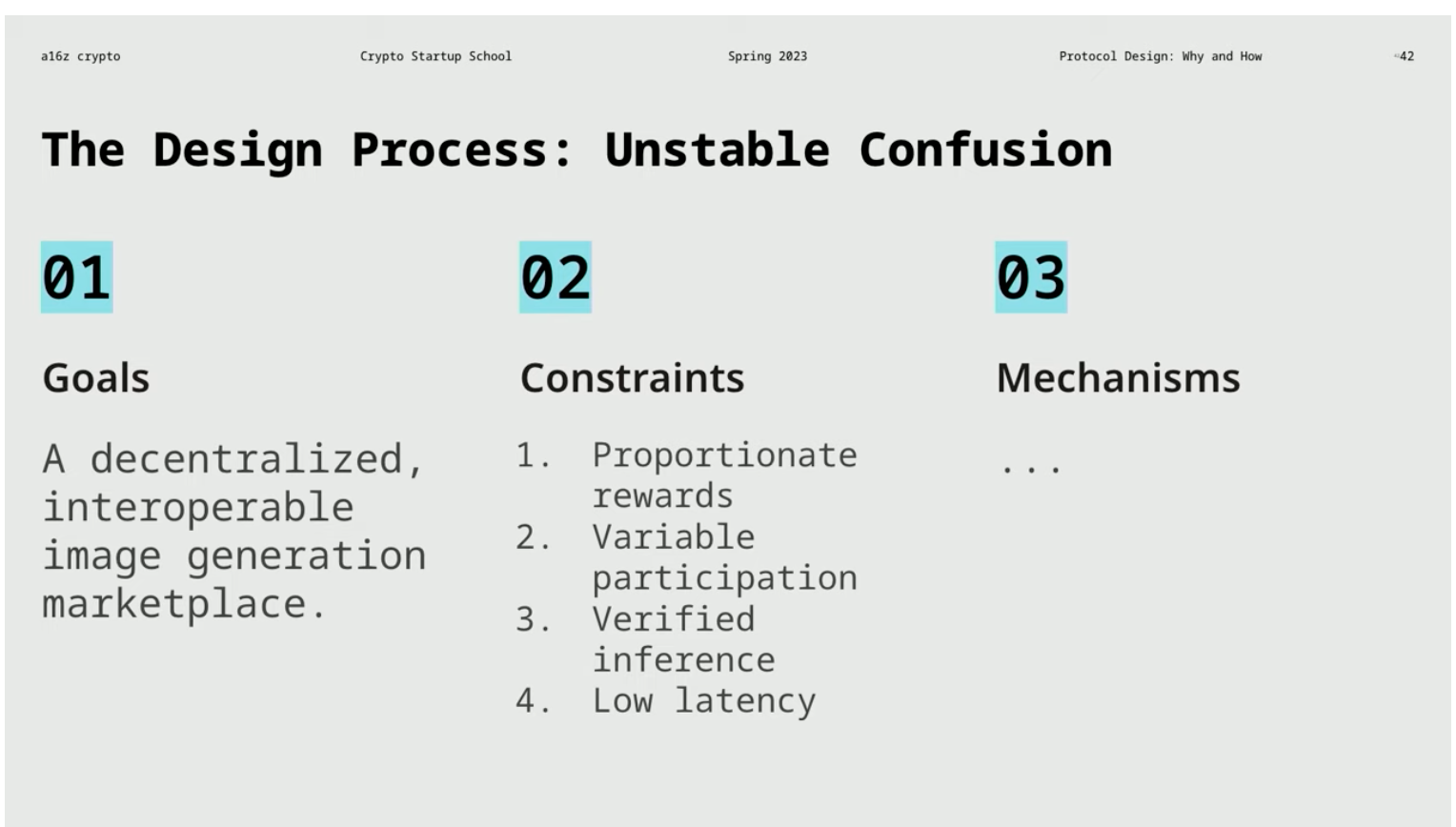
1. Verification mechanism
We can use methods such as game theory and cryptography to ensure the accuracy of reasoning. Game theory mechanisms can be used in dispute resolution systems, where users can escalate disputes and be arbitrated by specific roles. Continuous or sample auditing is another approach, by reviewing workers' work, ensuring that tasks are assigned to different workers, and recording which workers pass the audit. Zero-knowledge proofs in cryptography can generate efficient proofs to verify the correctness of reasoning. Traditional methods include trusted third-party institutions and user reviews, but there are centralization risks and network effects.
Other possible validation mechanisms include having multiple workers complete the same task, and the user chooses from the results. This may be costly, but if the cost is low enough, it can be considered an approach.
2. Pricing strategy
Regarding the pricing strategy, an order book can be established on-chain. It is also possible to use on-chain verifiable computing resource proxy metrics, such as gas. This approach differs from a simple free market, where users simply post what they are willing to pay for inference, which workers can accept, or they can bid to compete for tasks. Instead, users can create a proxy metric like gas, where a specific inference requires a certain amount of computing resources, and the amount of computing resources directly determines the price. In this way, the operation of the entire mechanism can be simplified.
Alternatively, an off-chain order book could be used, which is less expensive to run and potentially very efficient. The problem, however, is that whoever owns that order book may concentrate the network effect on themselves.
3. Storage mechanism
The storage mechanism is very important to ensure that the results of the work can be delivered to the user correctly, but it is difficult to reduce the risk of trust and prove that the work was delivered correctly. Users may question whether an item was delivered, similar to complaining about not receiving an expected item. Auditors may need to verify the calculation process and check the accuracy of the output results. Therefore, the output should be visible to the protocol and stored where the protocol can access it.
In terms of storage mechanism, we have several options. One is to store data on-chain, but this is expensive. Another option is to use a dedicated storage encryption network, which is more complex but attempts to solve the problem in a peer-to-peer fashion. Alternatively, there is an option to store the data off-chain, but this raises other issues, as whoever controls that storage system could influence other aspects such as the verification process and transmission of the final payment.
4. Task allocation strategy
The way tasks are distributed also needs to be considered, which is a relatively complex area. It can be considered that the worker chooses the task by itself after the task is submitted, or the agreement distributes the task after the task is submitted, and it is also possible to let the user or end user select the specific worker. There are pros and cons to each approach, and also consider the combination of ways the protocol decides which workers can request which tasks.
secondary title
a16z Encryption Entrepreneurship Course: After "Token Design", "Protocol Design" is launched
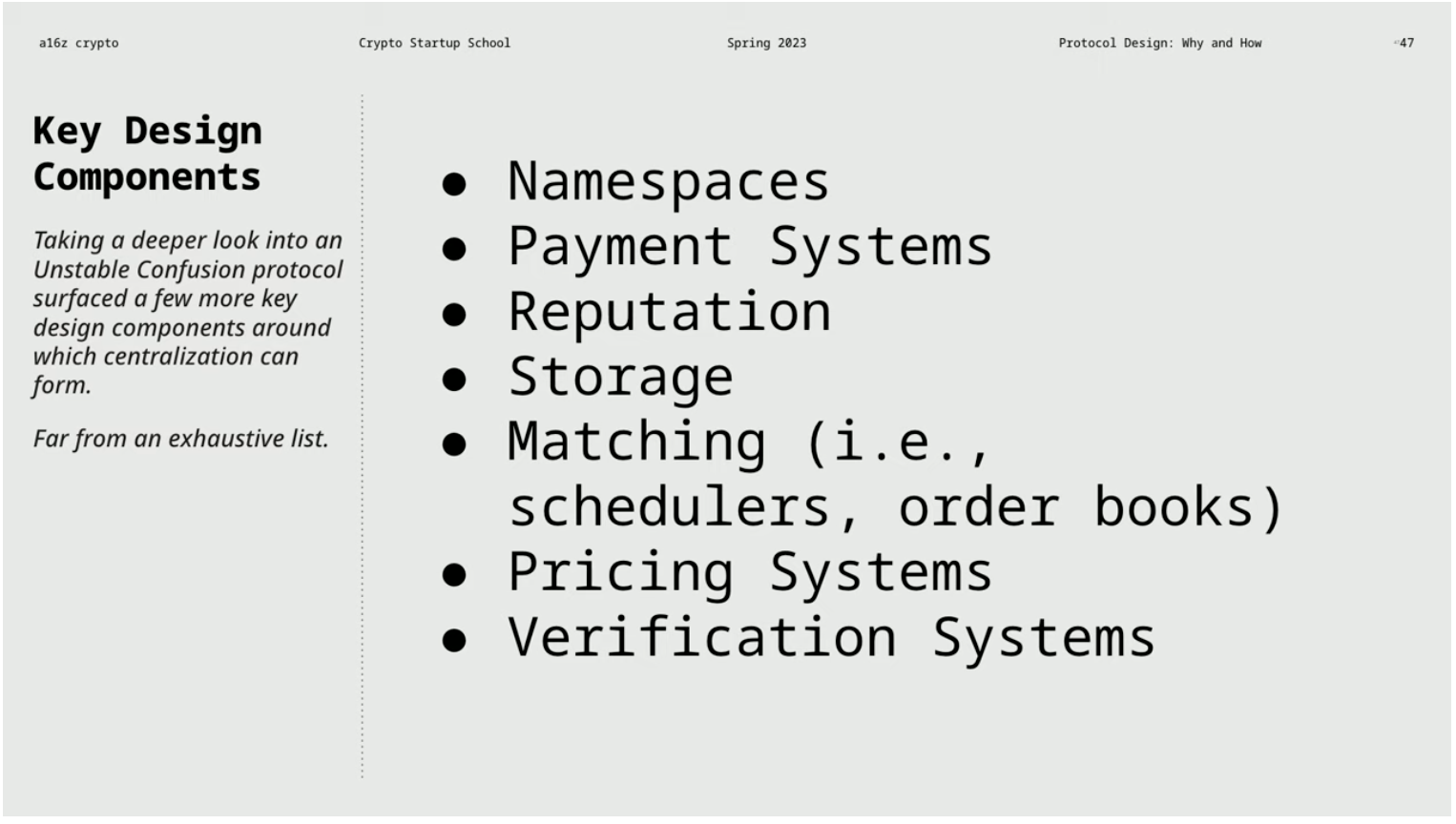
7 key design elements that can lead to centralization risk
text
Reduce switching costs and facilitate interoperability
text
Creating Decentralized Systems Using Web3 Technologies
text
In-depth research and selection of the best solution
When designing a protocol and determining a strategy, various aspects need to be studied in depth. For authentication, cryptographic solutions are usually the best choice. In terms of pricing, proxy metrics using on-chain verifiable computing resources can be adapted to a variety of different inference or machine learning tasks. In terms of task assignment, a protocol for updating worker capabilities and status in real time is adopted to distribute tasks fairly and allow workers to independently choose whether to accept tasks. For storage problems, solutions such as prototype sharding technology can be considered to solve problems in a short time window and adopt temporary storage methods.
When designing a decentralized system, the above considerations can help to build a system with long-term robustness and decentralization properties.